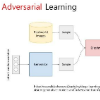Generating a surgical report in robot-assisted surgery, in the form of natural language expression of surgical scene understanding, can play a significant role in document entry tasks, surgical training, and post-operative analysis. Despite the state-of-the-art accuracy of the deep learning algorithm, the deployment performance often drops when applied to the Target Domain (TD) data. For this purpose, we develop a multi-layer transformer-based model with the gradient reversal adversarial learning to generate a caption for the multi-domain surgical images that can describe the semantic relationship between instruments and surgical Region of Interest (ROI). In the gradient reversal adversarial learning scheme, the gradient multiplies with a negative constant and updates adversarially in backward propagation, discriminating between the source and target domains and emerging domain-invariant features. We also investigate model calibration with label smoothing technique and the effect of a well-calibrated model for the penultimate layer's feature representation and Domain Adaptation (DA). We annotate two robotic surgery datasets of MICCAI robotic scene segmentation and Transoral Robotic Surgery (TORS) with the captions of procedures and empirically show that our proposed method improves the performance in both source and target domain surgical reports generation in the manners of unsupervised, zero-shot, one-shot, and few-shot learning.
翻译:在机器人辅助外科手术中以自然语言表现外科现场理解,生成外科手术报告,在文件输入任务、外科培训和手术后分析中可以发挥重要作用。尽管深学习算法的精确度最高,但部署性能在应用目标域(TD)数据时往往会下降。为此,我们开发了一个多层变形变形模型,采用梯度反向对立学习法,为多部外科手术图像提供字幕,描述仪器与外科利益区(ROI)之间的语义关系。在梯度反向对立学习计划中,梯度多片以负常数和反向更新反向传播,区分源和目标域和新出现的域性变异特性。我们还调查了带有标签平滑技术的模型校准模型,以及侧端层特征显示和 Domain适应(DA) 效果的模型。我们注意到了两个机器人外科外科外科外科数据集,在斜度反向反向反向对立的对立式学习计划中,梯度多位数和反向反向反向更新,在后传播中,在源和目标域域内,区分,对源和新出现的域内变异变异特性特性特性特性特性特性特性特性特性特性特性特性特性,我们对模型的模型的生成方法,改进了模型和外演制方法,改进了模拟生成的实地演制方法,改进了模型和外演制方法。




